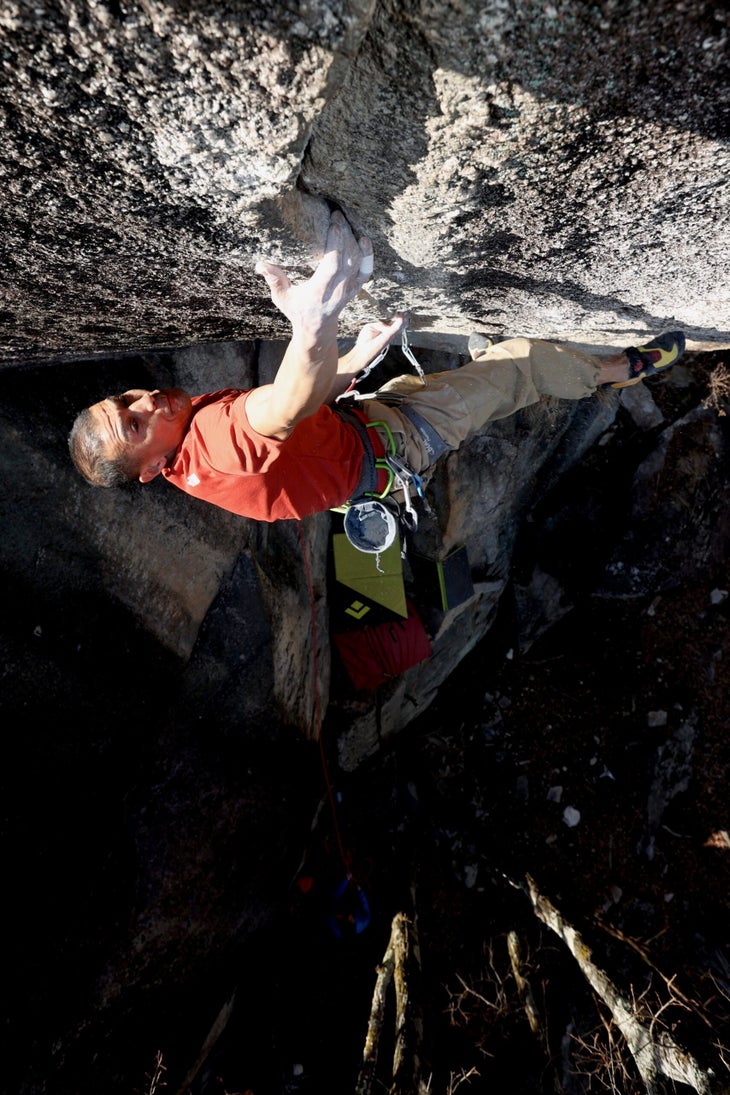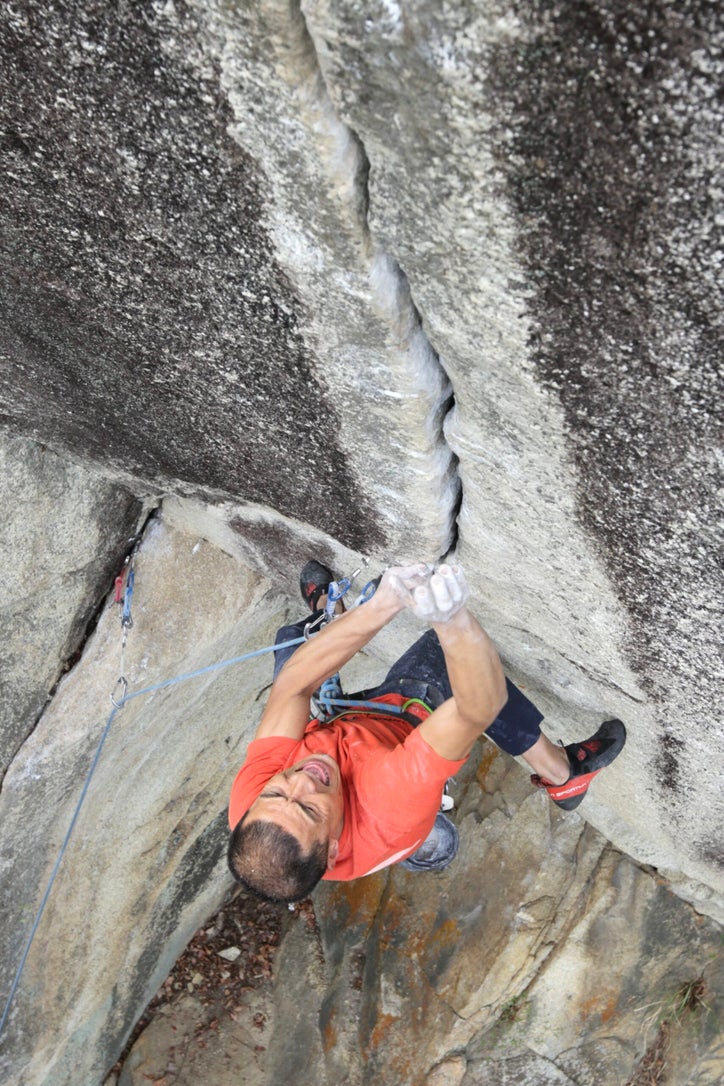Heading out the door? Read this article on the new Outside+ app available now on iOS devices for members! Download the app.
Japanese climber Yuji Hirayama continues to push his limits. By making the fourth ascent of Japan’s Daydream (5.14) in mid February, Hirayama has tackled his hardest trad project in years. In fact, he estimates the 50-foot overhanging crack is equal to Squamish’s legendary Cobra Crack (5.14b), which he climbed in 2009.
Hirayama, who celebrated his 55th birthday just a few days after Daydream, told Climbing he’s happier than ever, enjoying the wisdom and challenges inherent with aging, and has no intention of slowing down. Indeed, there is little evidence that years have mellowed Hirayama’s skill or stoke. He’s blasted up several bolted 5.14s in his 50s, including Peaceful Mountain (5.14d) in 2022.
Now, with Daydream, Hirayama has reignited a dormant passion for gear. “I know I’m not 20 years old anymore, and my climbing ability is different,” he said, “but I’m so glad that at my age I can climb like this. I just feel happy.”

To continue to progress as a climber, finding a balance was key, Hirayama said. In some ways, he said aging has helped him be more in tune with his body than ever before. “With my age, climbing is different. I cannot just follow a goal, first I have to follow myself.”
The 40-Year Daydream
Daydream, a 50-foot overhanging crack, has been on Hirayama’s radar since 1984. Back then it was an edge-of-atmosphere project for Japan’s leading climbers, mythic names like Isao Ikeda and Kiyoshi Hinotani. Hirayama has fond memories of watching from the sidelines as his mentors threw themselves at Daydream, following rigid ground-up ethics, protecting with mostly nuts, and thumbing their nose at the idea of a top rope. “I was 15, all the legends trying in front of me, and I’m just watching. I had only been climbing for a few months at that time,” he recalled, laughing.
Daydream remained unclimbed for nearly 40 years. “[The] sport climbing movement came to Japan in the 1990s, so no one [went] to Daydream,” Hirayama said. In the interim, Hirayama became something of a climbing rockstar.
Though his name may not be familiar to many younger American climbers, at the turn of the century, he was perhaps the world’s strongest crack climber. He has established high-end V14 boulders, was the first person to onsight 5.14b (White Zombie, Spain), the pioneer of several 5.15s, and a World Cup gold medalist—the first of Asian descent. He was also the second ascensionist of Tommy Caldwell’s Kryptonite (5.14d), America’s first route of the grade.
But Hirayama is perhaps best known for his efforts in Yosemite Valley. His 1997 onsight attempt of the Salathé Wall (5.13b; 2,900ft) saw him make it up to the Teflon Corner without a single fall. (This remained the best onsight attempt for over 20 years, until Adam Ondra fell at the Headwall.) In 2002, Hirayama made the second one-day free ascent of the line, cutting over six hours from Tommy Caldwell’s standing time. Hirayama and Hans Florine also repeatedly set and busted free records on the Nose (VI 5.9 C2; 3,000ft), battling the Huber brothers to lower the time throughout the 2000s.
Though more well known for sport, bouldering, speed ascents, and competitions, Hirayama is a traditional purist at heart, and has performed on the cutting edge of crack climbing throughout his career. His first notable ascents were 5.13- Yosemite finger cracks—The Phoenix and Cosmic Debris—at age 17. In 1996 he made an incredible onsight of The Sphinx Crack (5.13b), and in 2009 traveled to Squamish to climb Cobra Crack.
Projecting Daydream recently was a return to his roots, he said, and a catalyst for new ambitions as he ages. “Trad movement is coming back. People want to go more adventure style again,” he said.

A Return to Gear
Nearly four decades after it was first attempted by Japan’s leading climbers, Daydream succumbed in 2020 to an unpublicized ascent from Naoki Komine. Hirayama began working the line in April of 2022, after seeing an Instagram post from third ascensionist Wataru Nakajima.
In total, Hirayama reckons it took 18 days of projecting over two years to make Daydream a reality. This sporadic commitment was partially because of his busy schedule (he owns and operates a rock-gym chain) but also because Daydream is only viable in winter conditions. (Unlike his old-school mentors, Hirayama worked the route on toprope before his redpoint attempt.)
The route begins with an unprotectable 15-foot highball before the climber gets some small cams. The placements are generally quite good, “but I just wasn’t used to climbing on trad for the last few years,” Hirayama admitted. “I was afraid a little bit.” Hirayama’s gear ripped on more than one occasion during his lead tries.
While the first two ascensionists jammed the crack the entire way up, Hirayama and Nakajima chose to mainly layback. Daydream gets steeper the higher it runs, and the final crux sequence is between 60 to 70 degrees overhung and 12 feet out from gear by the end. “It has some risk of groundfall,” Hirayama said.
The crux is a V8 and V9 boulder problem back to back. “The first has a hard, painful jam,” Hirayama said. “I left some skin there.” After this, he managed to place a single piece of gear before the final runout, which he struggled to place without peeling off the tenuous holds.
Ultimately he came up with the strategy of Velcroing his offset cam to his harness, pre-clipped with alpine draws, to make it faster to place. “I can place very quickly then, without clipping,” he said. From this final piece is a techy, steep sequence transitioning a sidepull into an undercling before a long move up the crack. “It’s a big move, but safe,” he said. “I fell here a few times and the gear is good.”

The next moves are the mental crux, and the scariest part of the line. With the right hand sidepulling the crack and the other on a miserable sloper out left, he has to snag a right heel hook in the crack, and make a long dynamic reach to a jug. “I [blew] my heel several times,” Hirayama said. “You have to concentrate hard. Very hard.”
Adventure for the Next Generation
Daydream reignited Hirayama’s personal love for trad, but also reminded him of our sport’s rich history. “Modern climbers don’t know where we came from,” he said. “Many look for grade, fitness… Adventure is much more important.”
Hirayama recognizes his position as something of an icon, noting that his future projects will keep this focus on adventure in mind. “I want to bring more people to trad routes, to know what our sport means,” he said. “We started to use bolts only because it was necessary. Now it is standard. Without adventure, our sport is missing something.”
Hirayama maintained that the achievement of Daydream is not just his and the other ascentionists, but also that of the pioneering generation he watched going all out on the line in the early ’80s. They may not have had the fitness or gear to put it to bed, but they paved the way. “I want to thank that generation,” he said. “They showed us so many good parts of climbing. They showed us this line, proved it’s possible. They had the dream to do it … It’s teamwork over the generations.”
Author’s Note: Daydream is in an area with tenuous access, and locals reportedly have a semi-volatile relationship with visiting climbers. Hirayama and his team requested that Climbing does not disclose the location of the route.
